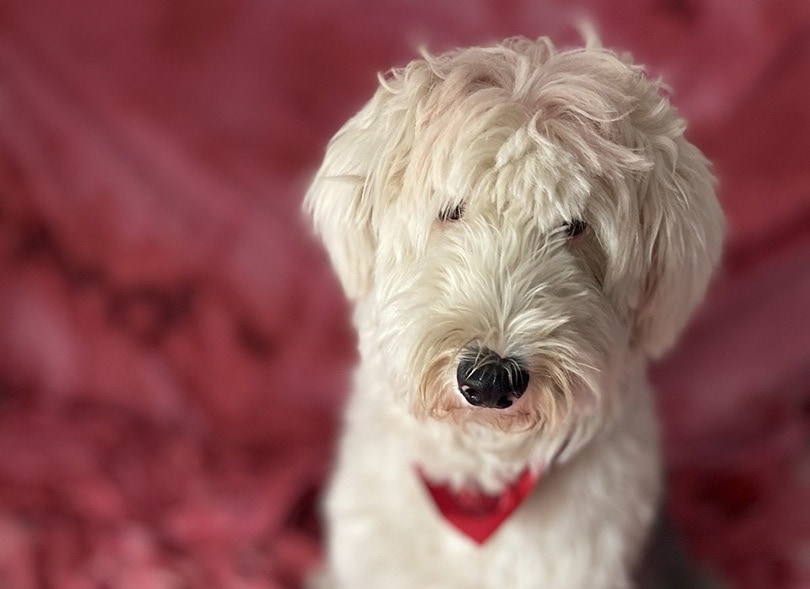Last Updated on February 3, 2024 by Fumipets
German Shepherd & Poodle Mix
| Height | 22-28 inches |
| Weight | 50-90 pounds |
| Lifespan | 10-18 years |
| Colors | Grey, brown, white, tan, black |
| Suitable for | Active families, those looking for a protective dog or exercise companion, owners with plenty of extra time |
| Temperament | Loyal, intelligent, active |
A Shepadoodle is a hybrid between a German Shepherd and a Poodle. They are very clever and energetic dogs. They may make wonderful pets for the proper home, but they will require someone to keep their bodies and brains challenged. They’re simple to teach, yet they might be reserved with strangers. They are devoted to their family and have a strong sense of loyalty. Indoors, they are often well-manned. They do, however, like to be outdoors and working on something. Many people like canine sports and other pastimes.
They are often classified as big to medium-sized dogs. It mostly depends on whose parents the puppy acquires features from. Although this isn’t always the case, females are normally smaller than men.
You never know what you’ll get with this mixed breed since it’s a mixed breed. Each parent’s qualities will be passed on to the puppies at random. As a result, you may end up with a dog with a variety of characteristics. Some people are more guarded than others. They might be a shaggy German Shepherd or have Poodle-like hair.
All of these dogs, however, have certain common characteristics. In this post, we look at them as well as oddball pups that may perform in a unique way.
Shepadoodle Puppies — Before You Buy
How much do Shepadoodle puppies cost?
This dog isn’t a purebred. Finding breeders that specialize in this dog is difficult, if not impossible. As a result, finding suitable pups might be difficult.
They may show up in local animal shelters and breed-specific rescues on occasion. However, these canines are usually older. Around the age of one to two years, many huge dogs are surrendered to an animal shelter. This usually happens when the dog gets older and more obnoxious. Some owners are unprepared for the level of effort required by such canines.
Accidental litters do, however, sometimes land up in shelters. Consider yourself fortunate if you chance to come upon a litter of Shepadoodle pups in your area. Puppies and adults are usually only charged $50 to $300 by rescues and shelters. Puppies are frequently more costly than adult dogs since they need more vet care on the part of the rescue.
You may be able to identify a breeder that produces Shepadoodle pups on rare occasions. A puppy will cost between $1,000 and $3,000, with the majority falling in the lower price range.
3 Shepadoodle Facts You May Not Know
1. They’re working dogs to the core.
Even though they are usually developed as companion animals, these dogs are not designed to hang around the home all day. German Shepherds and Poodles are both busy working dogs. As a result, their puppy will be incredibly active and always looking for something to do.
2. A Shepadoodle may be shy or extroverted.
These pups might be protective or highly friendly depending on which parent they receive features from. Because you won’t know where your dog falls until later in life, when socializing is less successful, all pups should be socialized.
3. The breed of Poodle is important.
The Shepadoodle is almost often bred from a Standard Poodle. This isn’t always the case, however. Because the kind of Poodle used has such a big influence on the size, you should ask the breeder what sort of Poodle was chosen.
https://www.youtube.com/watch?v=O5etnk2ETq8
Shepadoodle Temperament and Intelligence
The Shepadoodle’s temperament and intellect are mostly determined by the qualities that the puppy inherits. Shepadoodles, on the other hand, will all be active. They are energetic canines that need a lot of physical activity and mental stimulation. They need a lot of care from their owners, thus we only suggest them to families with spare time. This is not a dog you can leave outside for the most of the day.
These canines are best suited to larger households, since the additional family members can assist keep the dog amused and active.
These canines may acquire their German Shepherd parent’s protective instincts. Early socialization is critical in teaching them that strangers aren’t always bad. We advocate group puppy training programs because they offer both instruction and socializing for your dog.
Some dogs are highly territorial, and they will need substantial training and socialization throughout their lives in order to be polite of strangers, even if they are never sociable. Others may be sociable since the Poodle parent has moderated their protective tendencies. In any case, these dogs don’t seek out a lot of attention from strangers. They like to spend most of their time with their family. Of course, there are outliers.
It is critical that your dog be socialized, regardless of where they lie on the spectrum. Because puppies are frequently friendlier to outsiders than adults, you may not notice your dog’s protective instincts until they reach sexual maturity. Socialization will be more challenging and time-consuming at this phase. It’s far preferable to start while they’re still pups.
These dogs have a strong affinity with their owners. They show compassion and love to almost everyone, including adults and children. They like cuddling on the sofa, but many of them would rather run about and play with their family members.
Do These Dogs Make Good Family Pets?
Yes, if the family is active and has sufficient time to devote to this breed. The Shepadoodle requires a great deal of care. They need a lot of activity, as well as sociability and continual mental stimulation. For busy households, this is tough to do, which frequently results in a disgruntled and destructive dog.
These dogs will try to fulfill their requirements on their own if left to their own devices. (Consider leaving a bored 70-pound child alone in your house for an hour or so.)
In general, these dogs form tight bonds with all members of their family and get along well with youngsters. They’re large enough to cope with a child’s hyperactivity without being hurt, so fear-based biting is reduced. They also show a lot of respect for youngsters and aren’t likely to hurt them.
If you want to have this dog around children, socialization is encouraged, since it is always preferable to get them adjusted to a child’s normal behavior.
Does This Breed Get Along With Other Pets?
They might get along great with other dogs or they could be aggressive. Unless they were raised with another dog, many German Shepherds thrive best as the lone dog in the home. If there is already another dog in the house when they are adopted, they may be alright, but many will not tolerate bringing a dog in later.
Some Shepadoodles may inherit their German Shepherd parent’s territorial temperament. Others, like their Poodle parent, will be more welcoming of dogs.
Your best strategy is to expose your dog to a lot of other dogs so that they learn that other dogs aren’t out to harm them. Because there are generally many distinct pups in a puppy training session, this is a simple task.
Although the Shepadoodle does not have a particularly strong chase impulse, it is always present. They are typically not suggested in a household with small pets since they may try to pursue cats and other small animals. Because it is instinctive, training doesn’t help much.
What to Know Before Getting a Shepadoodle
Nutrition
The Shepadoodle is often classified as a “big dog,” while other canines may be smaller. As a result, we propose a meal made particularly for large-breed dogs. Although most dogs have similar dietary requirements, bigger breeds benefit from special nourishment to maintain their joints healthy. If they don’t lose weight, they’ll be more prone to joint issues later in life.
When feeding puppy Shepadoodles, you need be extra cautious. These dogs are prone to hip dysplasia because of their size. This has a hereditary component, but it also has an environmental component. This disease develops when the ball and socket of the hip joints do not grow in lockstep. They don’t match up because one develops quicker than the other. This leads to a lot of wear and tear.
When the joint has reached the end of its growth cycle, there is often enough damage to prevent the hip from ever lining up again. Degeneration of the joint will proceed, resulting in early arthritis, discomfort, and lameness.
Overfeeding pups may make them more susceptible to this illness since the additional calories interfere with their development. A puppy meal made specifically for large-breed dogs is often suggested. Carefully follow the directions. Free-feeding these dogs, particularly when they’re pups, is never a good idea.

Exercise
Although this dog is mostly maintained as a companion animal, it is a working breed. They need a large amount of area to expend their energy. Although having a backyard is preferred, these dogs may live well in a house without one as long as they are taken on frequent outings. These dogs are not appropriate for apartment life because to their huge size and activity requirements, which prevent them from adapting to tiny living spaces.
You should take your dog on lengthy walks every day, and you should expect to spend a lot of time standing about as your dog sniffs. Smelling is similar to reading books for dogs in terms of brain stimulation. As a result, offering chances for them to smell intriguing items will intellectually exhaust these canines.
Most canine sports are a good fit for these canines. Setting up an agility course in your backyard, even if you don’t intend to compete, may offer your puppy with much-needed mental and physical activity.
Due to their high energy requirements, we only suggest this dog for active families. It takes a lot of effort to keep them happy, and this may be challenging for the typical household.
Training
Because these dogs are clever, they will benefit from frequent training and mental stimulation. They are easily bored, which may lead to harmful conduct. However, training isn’t only about teaching this breed how to behave; it also serves as a deterrent to bored, destructive behavior.
These canines are loyal in addition to being clever. They will gladly listen to almost whatever their master says, as well as swiftly learn new orders. Because of this, they are one of the simplest dogs to teach. They aren’t known for their intransigence. If they do, it generally happens around the time they reach sexual maturity. This is colloquially referred to as the “teenage” stage, and it may be waited through.
Despite the fact that these dogs are normally simple to teach, expert training is still recommended. Group lessons are desirable since they allow dogs and humans to socialize with one another. Shepadoodles are known for their protective characteristics, which may be tough to manage on their own. We suggest hiring a professional unless you’ve already taught a dog with strong defensive instincts.
These dogs are often socialized and become well-behaved canines. You should keep socializing with them since it might wear off over time. Even if you carried your dog around as a puppy, it doesn’t guarantee that as an adult they’ll be welcoming of others. Adults need to engage with people and pets on a regular basis.

Grooming
Their grooming needs will differ significantly. It depends on the characteristics they inherit and how their coat develops. The coat of a puppy isn’t usually an accurate picture of their coat after they’ve reached sexual maturity.
A Shepadoodle, in any case, will need to be brushed every other day. If their coat is curly, this will help keep it clean and avoid matting. Brushing distributes natural oils into the fur, keeping it healthy and preventing skin issues. Brushing will remove dead hair and dirt from wiry-coat dogs. This frequent brushing is required regardless of the coat they have.
Dogs with longer coats may need much more brushing. Increase the frequency of your grooming procedure if your dog seems matted despite frequent brushing. Because your dog’s coat changes as they grow older, you may need to increase or reduce the quantity of brushing. A slicker brush, which is excellent at avoiding tangles, is frequently your greatest friend.
These dogs aren’t prone to getting filthy. They may, however, “hang on to” scents, particularly if they go swimming. As a result, you should plan on washing them with a soft soap on a frequent basis. It’s time to give your dog a wash if they’re smelling bad.
However, you should only wash them once every two months. More than this may disrupt their normal skin pH, causing a slew of issues.
Health
In general, these dogs are in good health. Because they are a mixed breed, they are less likely to develop the hereditary disorders that purebreds are prone to. Simply said, they have a greater number of potential features to inherit, which implies they are significantly less likely to receive any unique health-related traits.
However, this does not always imply that they are in perfect health. They are susceptible to a few issues that owners should be aware of.
Hip dysplasia is the first of them. This is a dangerous disorder that may be induced by overfeeding and overexercising pups. It has a hereditary component, but it can also be caused by overfeeding and overexercising puppies. You should never push your dog to exercise and should always feed them gently. Intense activity should be avoided until the dog is fully developed, since it might cause joint injury.
Hip dysplasia is a costly condition. Many dogs may be able to get away with using pain relievers and supportive treatments on a monthly basis. Others, on the other hand, will need surgery, which might cost thousands of dollars.
Another frequent issue is bloat, which may be life-threatening if the dog does not have emergency surgery very once. Bloat occurs when a dog’s stomach fills with gases. It might twist or not. As the stomach grows, this cuts off circulation to the stomach and other tissues, ultimately leading to necrosis. It does not go away on its own and might lead to death in a short period of time.
The specific etiology of this condition is unclear, but since it is more frequent in particular breeds, it is assumed to have a hereditary component. Larger dogs, such as the Shepadoodle, seem to be more susceptible.

Minor Conditions
• Pulmonic stenosis
• Seborrhea
• Diabetes
Serious Conditions
• Bloat
• Hip dysplasia
• Degenerative myelopathy
• Panosteitis
Males vs. Females
Males are often bigger than females. Because the Shepadoodle’s size varies so much, this isn’t always the case. Males, on the other hand, have a larger weight threshold than females. Of fact, there is some overlap between each sex and outlying dogs.
Neither sex protects the other more than the other. Males, contrary to popular belief, are not generally more violent or territorial. It is far more dependent on whose parent the dog acquires features from. A female with the protective instincts of a German Shepherd is more likely to be violent than a guy who behaves largely like a Poodle.
Finally, sex should probably not be a factor in your purchase choice. In most circumstances, the changes aren’t significant enough to matter. It is mostly determined by your particular choices.
Conclusion
The Shepadoodle has a lot of promise as a family dog. They are devoted to their family members and show love for them. Most are quite simple to teach and readily obey their owners’ commands. This breed is not known for its obstinacy. Because of their greater stature and courteous disposition, they are very fantastic with youngsters.
They may, however, be a pain to deal with. They will demand a lot of physical activity as well as cerebral stimulation. They are not the kind of dog that can spend the most of their time at home. Many of them, on the other hand, demand daily engagement with their humans, at least an hour of intensive activity, and many training sessions. For the ordinary household, this may be too much. This dog is best suited for a busy household searching for a constant companion. Most of the time, someone should be at home with the dog, or you might consider doggy daycare. This isn’t the breed for you if you’re seeking for a dog to cuddle on the sofa while you’re at work from 8 to 5.


















